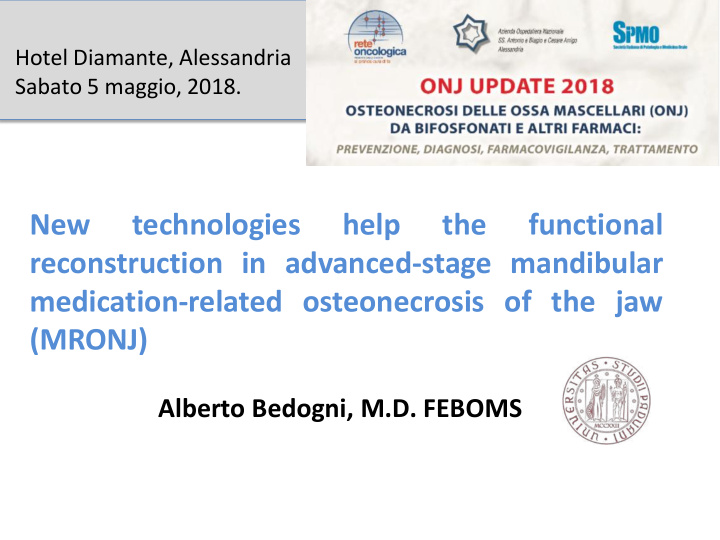



Hotel Diamante, Alessandria Sabato 5 maggio, 2018. New technologies help the functional reconstruction in advanced-stage mandibular medication-related osteonecrosis of the jaw (MRONJ) Alberto Bedogni, M.D. FEBOMS
Declaration: No potential Conflicts of Interest Faculty: Alberto Bedogni, MD, FEBOMS • Director, Regional Center for Prevention, Diagnosis and Treatment of Medication and Radiation-related Bone Diseases of the Head and Neck (DGR 2707, 12/2014) Hospital Trust of Padua, Italy • Assistant professor, Unit of Maxillofacial Surgery, Department of Neuroscience-DNS, University of Padua • Board member of the Expert Panel Recommendations of the Italian Societies for Maxillofacial Surgery (SICMF) and Oral Medicine and Pathology (SIPMO) on MRONJ Relationships with commercial interests: – Sintac s.r.l. Research Grant , June 2017. “ In vitro” planning and manufacturing of biocompatible customised mandibular bone substitutes using CAD-CAM technology
Aim of the study Safety and long-term outcomes of mandibular reconstruction using patient- specific mandibular replicas.
Material & Methods Study design: • Retrospective cohort study Setting: • Unit of Maxillofacial Surgery of Padua Study period • March 2012- February 2018 Eligibility criteria: • MRONJ patients who underwent segmental resection of the mandible and simultaneous reconstruction patient-specific mandibular replicas.
Material & Methods Basic technology • CAS: computer assisted surgery • CAD-CAM : Customized mandibular implant • CT scan images to STL format (Mimics software (Planning of resection, cutting guides, mirroring of the healthy v.14.12; Materialise, Belgium and digital software (Direct metal laser sintering) side and design of the customized prosthesis) ClayTools System, Wilmington, MA).
Material & Methods Surgery: 1- Guided surgical bone resection 2- Implantation and bicortical screw fixation 3- Suprahyoid and Genioglossus muscle reinsertion
Results Patient’s features: o 10 consecutive MRONJ patients (male=4, female =6) out of 20 eligible o Mean age 69 years (59-78 years) o Breast cancer was the most common diagnosis (5 cases) , followed by MM (3 cases) . o Zoledronate was the most common antiresorptive o five patients had previous surgery o Stage 3 was the most common (7 cases) , followed by stage 2b . o All patients were ASA 3 .
Results 1. Safety: o Mean Duration of surgery 270 min (range 141-375) o Mean hospital stay 12 days (4 -44 days) o Oral feeding: 1.4 days (range 1-3) o Temporary Tracheostomy (1 pt.) o Perioperative Complications: • One patient died 4 days postop (ARDS) • Severe facial swelling (1 case) • Postop dehiscence (2 cases) • Extrusion (2 cases) 2. Long-term o Mean follow-up: 26months (range 3-50) o Stable occlusion o Stability of the implant over time : • No dislocation/fracture • Extrusion (1 case) 26months later
67 y-o male, metastatic prostate cancer (monthly Zoledronate 12 courses) MRONJ mandible (stage 3 SICMF-SIPMO)
4-Y FOLLOW-UP
59 Y-O, breast cancer, trigger: periodontal infection, MRONJ mandible (stage 2b SICMF-SIPMO)
Computer-assisted reconstructive surgery
1-Y FOLLOW-UP
Discussion “Functional and anatomic surgery rather than resective” o Adequate lower lip support o Facial Symmetry maintained o Immediate recover of TMJ function o Tracheostomy tube unnecessary o Anticipated oral feeding resumption Stable coverage (inner/outer) essential Bedogni A, Bettini G, Ferronato G, Fusetti S, Saia G. Replacement of fractured reconstruction plate with customised mandible implant: a novel technique. Laryngoscope 2014 , 124(2): 401-4. doi: 10.1002/lary.24230. ISSN: 0023852X
Conclusion Pro’s: o Reduced surgical time o Immediate restoration of oral functions o Reasonable aesthetic result in one go o Well-tolerated surgery Con’s: o Dental rehabilitation not feasible To be done: o Improve perimplant surfaces with promotion of human cell adhesion o Bacteriostatic effect of the construct o Biomechanics in the long-term o Dental rehabilitation
Acknowledgements Dr Giorgia Saia, MD 1,2 Dr Giordana Bettini, MD 1,2 Dr Nooshin Abbasi, PhD 1 1 Unit of Maxillofacial Surgery, Department of Neurosciences-DNS, University Hospital of Padua, Italy 2 Regional Center for Prevention, Diagnosis and Treatment of Medication and Radiation- related Bone Diseases of the Head and Neck (DGR 2707, 12/2014) Dr Andrea Sandi SINTAC S.r.l.. Biomedical Engineering - Trento alberto.bedogni@unipd.it
• 54 y-o female • Disease: breast cancer with bone metastases to hip and spine (Jan 2009) • Chemo: daily exemestane • Antiresorptives: i.v. (4mg/28d) zoledronate (Jan 2009- Jan 2011) • Comorbidities: multiple SREs spine MRONJ diagnosis: February 2011 (47 years old) Periodontal infection, spontaneous tooth loss (right maxilla), with abscess formation and cutaneous drainage to the left cheek; progressive multiple sites of bone exposure and painless suppuration Medical treatment: • withdrawal of zoledronate 7 yrs. • monthly oral penicillin/metronidazole • daily clorexidine mouth rinses
March 2018
Osteonecrosis of the middle cranial fossa April 2018
Recommend
More recommend